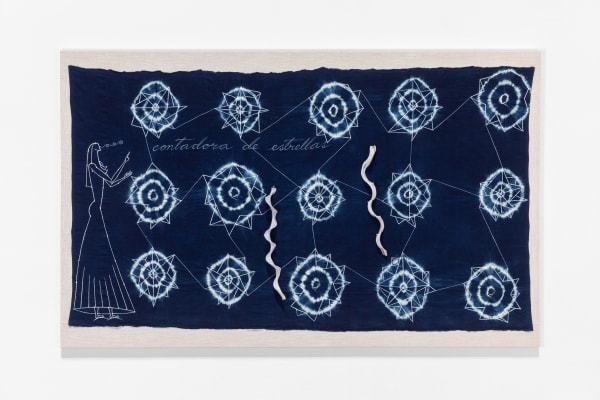Mendes Wood DM New York
Mendes Wood DM is proud to present Bestiary & Idols, a solo exhibition of recent works by the Cuban-born artist José Bedia. The exhibition centers on two themes: fauna and mythology. Mythological animals are hallmarks of the artist’s spiritual and transcultural research into a universal language of the cosmos. His path through this research has been shaped by decades-long contact with various indigenous communities and their imagery, systems of knowledge, and material culture.
After studying at the Escuela de Artes Plásticas San Alejandro and the Instituto Superior de Arte in Havana, Bedia began collecting archaeological materials in 1976; he then participated in the landmark 1981 Volumen Uno exhibition at the International Art Center in Havana. Employing acrylic, textiles, and assemblage, his work is nourished by long-term links to communities in Africa and the Americas. He first traveled to Africa in 1985, sent to Angola as a soldier in Cuba’s intervention into the Angolan Civil War. Since this conscripted beginning, he has developed ties with communities in Zambia, Botswana, Mali, Kenya, Tanzania, and Burkina Faso, all of which sustain his practice.
Bundanga (2020) features an ochre checkerboard textile from Mali on which Bedia intervened by painting pictographic figures from Palo Monte, an Afro-Cuban diasporic religion. In Kikongo, Bundanga is the term for both “sorcery” and “knowledge.” Bedia works in contrast to art that is, in his words, “secular and constrained to an immediateness of the right now.” The artist aims rather to recapture the atemporal and rescue the religious content inside images used as icons. In dialogue with the symbolism of cultures aware of the inextricability of human and animal experiences, the gesture of Bedia’s bestiary is one of healing and illumination through ritual.
The exhibition also casts a focus on animals revered as idols within indigenous societies. Two monumental paintings on canvas, Mobile (2022) and Dos Ídolos (2022), are inspired by myths from the Seri people of the coast of Sonora, Mexico. The works imitate the warp and weft of a textile, which Bedia achieved by dragging his hand across the canvas. Dos Ídolos depicts female idols in the form of manta rays who conjure duality and symmetry in nature. This same notion is reflected in Mobile, showing a giant leatherback turtle dragging a swimmer through the ocean; the subject is intimate to the spirituality of the Seri and their relation to the Sea of Cortés. The imagery is further familiar to many indigenous origin stories in which humankind rests on land, crafted by an animal deity, surrounded by water.
For Bedia, evoking alternative ways of seeing the world is an invitation to expand on the legitimacy of traditional cycles of learning and knowing. Perhaps this is most present in the artist’s conversation with mythological archetypes, as they can be read equally as geoglyphs, shadows, constellation figures, or skeleton keys to the spirit world. It would be a mistake, however, to categorize the artist’s approach as purely mytho-historical, since his works also result from direct observations of the natural world and lived experience.
Bedia’s recurrent use of half-cosmograms (representing sky/earth) deviates from the right angles of Western art history: at once, he conveys cosmological observations through the works’ physical forms and engages in unconventional storytelling through objects. The material assemblage in the half-cosmogram All the Pretty Horses (2024) references Cormac McCarthy’s best-selling novel, Mexico, and the artist’s early contact with horses during his childhood in Cuba. This work, rich in material and immaterial references, is characteristic of Bedia’s collecting across a wide breadth of sources, a practice at its heart celebratory of transcultural resistance, recovery, and repair.
José Bedia (b. 1959, Havana, Cuba) lives and works in Miami, FL, USA.
His solo exhibitions include Bestiary & Idols, Mendes Wood DM, New York, USA (2024); Simetria Natural, Fredric Snitzer Gallery, Miami, FL, USA (2023); José Bedia, Viaje Circular (Circular Journey), The Museum of Contemporary Art of Monterrey, Nuevo León, Mexico (2023); On the Frontier: The Art of José Bedia, El Museo Cultural de Santa Fe, Santa Fe, NM, USA (2016); Somalian Prey, Museo San Telmo, San Sebastian, Spain (2015); Transcultural Pilgrim, curated by Judith Bettelheim and Janet Catherine Berlo, Miami Art Museum, Miami, FL, USA (2012); Transcultural Pilgim, Fowler Museum, UCLA, Los Angeles, CA, USA (2012); Entre dos Mundos (Between Two Worlds), Instituto Valenciano de Arte Moderno (IVAM), Valencia, Spain (2010); Cosas Redondas (Round Things), Fort Lauderdale Art Museum, Fort Lauderdale, FL, USA (1995); De donde vengo(Where I Come From), Institute of Contemporary Art, Philadelphia, PA, USA (1994); Brevísima Relación de la Destrucción de las Indias (A Brief Account of the Indies’ Destruction), Carrillo Gil Museum of Contemporary Art, Mexico City, Mexico (1992); Persistencia del Uso (Persistence of Use), National Museum of Fine Arts, Havana, Cuba, where he was awarded the Grand Prize of the Landscape Salon (1984); and Volumen Uno, International Art Center, Havana, Cuba (1981).
He has been included in many landmark group exhibitions, including Chosen Memories: Contemporary Latin American Art from the Patricia Phelps de Cisneros Gift and Beyond, MoMA, New York, NY, USA (2023); Latin American Artists of the 20th Century, MoMA, New York, NY, USA (1993); Ante América: Cambio de Foco, displayed at la Biblioteca Luis Ángel Arango, Bogotá, Colombia, Museo de Bella Artes, Caracas, Venezuela, The Queens Museum of New York, NY, The Spencer Museum of Art, Lawrence, KS, USA (1992); and Magiciens de la Terre, Centre Pompidou, Paris, France (1989); among others.









